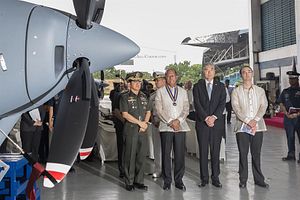On July 27, the United States delivered two new military surveillance aircraft to the Philippines during a handover ceremony. The delivery was yet another example of ongoing cooperation between the two longtime allies as they seek to confront a terrorism threat that has only grown in Southeast Asia in recent months.
As I have noted before, U.S.-Philippine security cooperation has been ongoing for decades. Amid the limited capabilities of the Philippine military (AFP), U.S. assistance has helped the Philippine government confront various internal challenges, ranging from communism to terrorism, while also deterring external threats from first the Soviet Union and then a rising China (See: “The US-Philippine Alliance Under Duterte: A Path to Recalibration”).
Though the environment for bilateral collaboration has been complicated since Duterte assumed the presidency last June (albeit to a level less than the hype may suggest), the convergence of interests between the two nations has been demonstrated by the AFP’s struggle against Islamist militants in the city of Marawi on the conflict-ridden southern island of Mindanao in the past few months (See: “US Terror Aid to Philippine Signals Enduring Defense Ties Under Duterte”).
U.S.-Philippine cooperation in the area of counterterrorism is by no means new. According to U.S. government estimates, Washington has provided more than $179 million in counterterrorism equipment and training – including small arms, ammunition, communication tools, and surveillance equipment – over the past decade. This is in addition to other forms of support, from infrastructure upgrades at Philippine military installations to advice and assistance from U.S. Special Operations Forces.
Little surprise, then, that we have seen Washington’s counterterrorism assistance to Manila once again in the spotlight amid the Marawi crisis. Since the outbreak of the crisis in May, the United States has been assisting the Philippine military – largely by providing intelligence and supporting surveillance and reconnaissance operations – even though much of this had initially been going on quietly given complications that have arisen under Duterte.
Last week saw yet another example of this assistance. On July 27, the United States formally delivered two new Cessna 208B Grand Caravan intelligence, surveillance, and reconnaissance aircraft to the Philippine Air Force (PAF) during a handover ceremony in Villamor Air Base.
The two new aircraft, valued at 1.67 billion pesos ($33 million), were donated via the U.S. National Defense Authorization Act Building Partnership Capacity Program. The transfer ceremony was attended by U.S. Ambassador to the Philippines Sung Y. Kim and Deputy Commander of Pacific Command Lt. Gen Bryan Fenton on the U.S. side, and Defense Secretary Delfin Lorenzana, AFP Chief of Staff Eduardo Ano, and Commanding General of the PAF Lt. Gen. Edgar Fallorina on the Philippine side, amongst other officials.
Though the handover of just two aircraft may not seem like much and Washington is far from the only partner assisting the Philippines in this respect, it is still a much-needed boost for the AFP, which is quite limited in its surveillance capabilities (See: “Where is the Philippines’ Air Force Modernization Under Duterte?“).
The aircraft were handed over to the PAF’s 300th Air Intelligence and Security Group (300 AISG), which is the leading unit for air intelligence, surveillance, and reconnaissance operations for the AFP. As the Department of Defense (DOD) pointed out in a statement, the aircraft would provide Manila with technologically advanced ISR capabilities, including line-of-sight live data and air-to-ground info streaming. Such capabilities are important to both locate terrorist groups as well as protect and support AFP personnel on the ground.
Following the ceremony, the C-280B aircraft flew to Edwin Andrews Air Base in Zamboanga, with in-country flight training for the aircraft beginning August 1. As the AFP continues to battle it out in Marawi and the Philippines confronts the broader threats emanating from terrorism and militancy, this capacity boost will no doubt be a welcome one.































